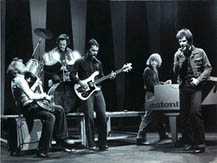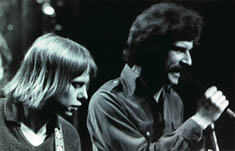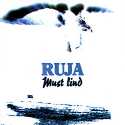 |
Vol 2, No 3
24 January 2000 |
|
|
 M U S I C:
M U S I C:
Estonia's Purveyors of Prog Mel Huang If we delve into the surprisingly long and accomplished history of Estonian rock music, the one group that serves as a major focal point is Ruja. This experimental and groundbreaking group managed to gain massive public devotion, while developing its intricate pieces into some of the best examples of progressive rock. Ruja easily kept pace with similar music heard on illegally imported cassettes, from bands such as Genesis, Yes, Emerson Lake and Palmer and King Crimson. However, throughout its 17-year existence (which began in 1971), the band kept a distinct Estonian flavour in its music and became the best-loved cult rock band in the country. Its former members are a "who's who" of the current Estonian music world, many of them famous beyond the country's borders. What was remarkable about Ruja is that it was essentially the very first rock band in Estonia to perform in Estonian. Many other bands opted to remain instrumental, due in large part to the watchful eye of the KGB. However, Ruja took the words of well-known prose writers – especially contemporary poet Juhan Viiding (who published under the pseudonym Jüri Üdi) and Ott Arder – and incorporated it into their brand of adventurous music. Of course, members of the band had several significant run-ins with the KGB and had some material banned. Though dozens of tracks were recorded in the 1970s, most remained unreleased due to a lack of opportunity. It was not until 1980 before they were allowed to release something, a self-titled EP with one of their most creative pieces, "Põhi, lõuna, ida, lääs" ("North, South, East, West"). In the early 1980s, Ruja teamed up with contemporary poet Ott Arder and exploited the growing teenage angst, partly from repression by Soviet authorities. The lyrics took on a much more national flavour, though they were of course not allowed to release such songs. However, the many concerts played by the band during that time re-ignited the idea of a free Estonia, sowing the seeds of the "Singing Revolution" years later. However, it was the music composed by these excellent musicians that really showed their genius. Though the style of music changed over the years (through four distinct periods), it remains unique — best described by the term rujaline,
The band moved into its second phase (1975-1980) with the departure of primary composer Rein Rannap, who is replaced by another piano virtuosos, Margus Kappel. The song-writing team of Kappel and Nõgisto, again often with the prose of Juhan Viiding, created some of the most fantastic pieces in the history of Estonian progressive rock. If music export was allowed at the time, there is little doubt that Ruja would have become an international sensation. The new rhythm section of bassist Priit Kuulberg and the 15-year old Ivo Varts brought a different style to the band. Longer, more complex pieces emerged, earning the band an army of loyal fans. The product of this era, mostly unreleased as well, showed that Estonian musicians, despite being hampered by the Iron Curtain, could compete with their counterparts in the Free World. The band had another run-in with the KGB during their co-operation project with keyboardist Olav Ehala on the rock opera "Johnny." The cries for freedom of the young rebel depicted in the story caused immediate response from the authorities, banning the production after ten shows. But with the coming punk age, Ruja went through another major flux. Following some other projects, the third era of Ruja (1980-1983) brought back former members Tiit Haagma on bass and Rein Rannap on keyboards. However, following the trend of the time, the music shifted towards simple, '60s inspired rock and roll, as well as punk. Again Rannap took over the role of composer, now using the words of poet Ott Arder. Many of the songs took on a more overtly national tone, and the endless touring by the band earned them a legion of fans. More importantly, the music and words were a wake-up call for a new generation of Estonians, showing the power of the song. The song "Eile nägin ma eestimaad" ("Yesterday I Saw an Estonia") became an anthem for the age. Personality problems led Ruja into the fourth and final era (1985-1988). The joining of accomplished progressive rock musician and composer Igor Garšnek on keyboards brought the band back to that form of music, though in a more snappy and short version. By now, vocalist Urmas Alender took over much of the lyric writing, penning some emotional classics showing he is as talented as any of the well-known prose writers in Estonian history. With the shorter, snappy '80s pop-influenced songs, Ruja began earning a name for themselves outside Estonia. Despite suffering many changes in the rhythm section, the band, along with new management, ambitiously toured around the former Soviet Union. However, this desire by new management to break into the other markets of the ex-USSR caused endless friction in the band — as its original mantra of being an Estonian-language band was challenged. The recording and performing of songs in Russian, along with the endless tours to remote places like Tajikistan and Siberia, caused the original formula to crack. Guitarist Jaanus Nõgisto leaves the band, and it falls apart several months later. Ironically, at the time their swan song appeared to be the Russian-language LP Puts budet vsjo (Let it be All). As the band fell apart, Estonia entered into the "Singing Revolution" that Ruja partly helped create. Perpetual hounding by the KGB continued, with singer Urmas Alender taking off for Stockholm joining many other Estonian musicians. But the success of the "Singing Revolution" brought about the restoration of Estonia's independence. However, there was no more Ruja, as everyone went their separate ways in post-Soviet reconstruction. Ruja, however, did reunite for one final concert, albeit for the saddest of all occasions. On a stormy 28 September 1994, the ferry Estonia sank travelling between Tallinn and Stockholm. Among the 853 victims of the tragedy was one Urmas Alender, the vocalist and soul of the band. Within weeks of the tragedy, former members of the band took the stage for one last time at a memorial concert – bravely joined by Yoko Alender, the teenage daughter of the legendary singer. A limited memorial CD, Many years later, as Estonia stood much stronger on its two legs, the generation that grew up singing "Eile nägin ma Eestimaad" found itself nostalgic. The former members of the band, putting aside past differences, took an ambitious project to release the first multi-CD boxed set in Estonian history. The end result is the ironically-titled 5-CD set Need ei vaata tagasi... (Not Looking Back at Them...). As the band had a wealth of unreleased material, the boxed set allowed the band to finally release the dozens of songs from 1971 to 1988. Today, the former members of Ruja are all successful in their own way. Rein Rannap is a well-known composer and pianist, Margus Kappel a strong presence in the rock music scene, and Igor Garšnek a respected music critic and composer. Jaanus Nõgisto steps away from the head producer's job at public television ETV to be a freelance producer, alongside the busiest music producer in Estonia, Priit Kuulberg. Tiit Haagma takes his skills as a world-class sailing champion and is a successful sail-maker, while bassist Vladislav Petchnikov is a successful progressive rock radio DJ. Though Ruja has not been active for over a dozen years, the music and words of this legendary Estonian band remains in the hearts and minds of Estonians. The sell-out of the limited CD boxed set in less than a week is a testament to the legacy of the band. And as interest in this historic progressive rock band grows abroad, the music will live on. Mel Huang, 22 January 2000 This article is a revised version of the article on Ruja in CER issue 19, 1999 For More Information:
|
|
![]()
Copyright © 2000 - Central Europe Review and Internet servis, a.s.
All Rights Reserved

 Must Lind (Black Bird), was released to help support Alender's daughter.
Must Lind (Black Bird), was released to help support Alender's daughter.